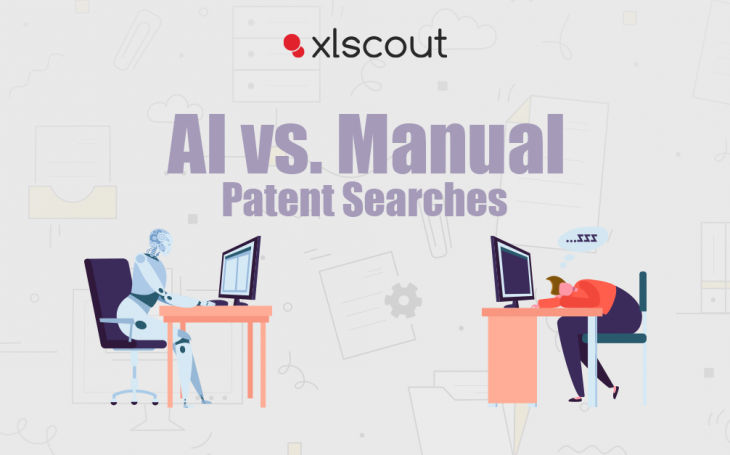
“While AI-based patent search tools are quick and easy to use, they can be combined with manual patent searches performed by experienced analysts to produce better results.”
The global Artificial Intelligence (AI) market is growing rapidly. Henceforth, making it clear that AI is becoming the answer to most software and service needs. AI has even made its way into our homes, with smart home systems increasingly incorporating Internet of Things (IoT) technology as well as a master AI virtual assistant.
Without a doubt, technology has made inroads into the intellectual property-based service sector. For example, there are numerous AI-based automated patent search tools available to assist with patent searching. Although many of these are still in the training phase, they are expected to mature. Following that, the question is whether to use low-cost AI patent search tools or invest in outsourced, manual patent searches.
With AI-based patent search tools available on subscription-based models at reasonable prices, the above-mentioned dilemma becomes even more pressing. So, while patent search tools are easy to use, they can be combined with manual searches to produce better results. The following article compares both options and defines scenarios in which these models can be used.
When Should You Use Automated Search?
- Prior Art for Information Disclosure Statement (IDS) Submission: To validate the innovation, relevant prior art must be submitted when submitting an IDS. Automated searches can be employed to include prior art in IDS and reduce patent prosecution turnaround time.
- Quick Validation: Automated searches can be utilized to quickly validate concepts during the ideation stage. Such AI-powered automated search tools provide innovators with access to prior art, allowing them to innovate around existing patents.
- Cost Savings: Because most AI-based patent search tools are relatively inexpensive, there is no need to keep a budget for outsourcing patent search services. For patent searches, many AI-based patent search tools employ a pay-per-use model.
- New Technological Domains: Unique and revolutionary inventions frequently pose a problem for in-house subject matter experts (SMEs) during the search for pertinent new prior art. In such cases, the subject may be lacking in direct prior art, but AI-based patent search tools can be useful. They can be used to comprehend and derive similarity from the most recent technologies to identify potential prior art.
Our Methodology
XLSCOUT’s Novelty Checker makes patent searches easier for inventors. The tool searches for similar inventions to yours to determine whether a patent is feasible.
A step-by-step guide to conducting an AI-based patent search with Novelty Checker can be accessed by clicking here.
XLSCOUT put the use of reinforcement learning to its AI-based Novelty Checker (patent searching tool) to get quality patent research reports in just 5 minutes. The Novelty Checker uses reinforcement learning to filter the noise by pulling up the relevant results at the top. To be precise, it assists in conducting patentability search to help you ensure that your innovation is unique. By selecting a few relevant and non-relevant results, users can apply them to the result set. The system takes the user’s feedback and then learns from it. It uses conceptual searching and re-ranks the results by bringing the quality results to the top and sending the noise to the bottom.
When Should You opt for Manual Patent Searches?
- Interchangeable Terminologies: Similarly, in such crowded patent spaces, terminologies that coincide with those of the invention are common. Some terms in the technology domain are used interchangeably. To conduct a thorough prior art search, all such terms must be manually searched in a context-appropriate manner.
- Crowded Patent Spaces: In crowded patent spaces, manual patent searches can assist in distinguishing between existing patents and prior art for the given invention. Because minor differences in such prior art give rise to patentability. Thus, distinguishing such subject matter from the available prior art is advantageous.
- New Application Areas: Inventions that are not novel by themselves but novel in their application necessitate extensive manual prior art searches to uncover any prior art that is similar to the given application. This allows claims to be written in a way that ensures high licensing value in the future.
- Avoiding 103 Rejections: Manual patent searches can assist innovators in analyzing the patent prosecution history of related patents in order to avoid obviousness rejections under 35 U.S.C. 103. This can help them learn from the prosecution approaches of patents with similar technology combinations. A customized patent search can thus decrease the likelihood of receiving a 103 rejection.
- Contemporary Searches: With a rapidly growing patent market and growing competition in patent filings, it is critical to understand the state-of-the-art (SOA) in terms of validity. To understand competitors’ patent filings, modern searches that include both novelty and SOA searches are required. This also enables innovators to draft patent claims by aligning their patent filing strategy with competitors.
The Hybrid Model: Combining Manual and Automated Searches
Manual searches at the initial ideation and concept approval stages can be time-consuming. This is especially true for organizations with large R&D teams working on multiple innovations at the same time. AI-based tools address this issue by providing quick prior art search results, allowing R&D teams to leverage the role of IP in their processes. Even though the majority of these AI-based tools are still in the early stages of training and data input, they can supplement manual patent searches in some cases. While AI-based tools are cost-effective and time-efficient, manual searching is more reliable and relevant. Using both at the same time can result in truly superior results.

